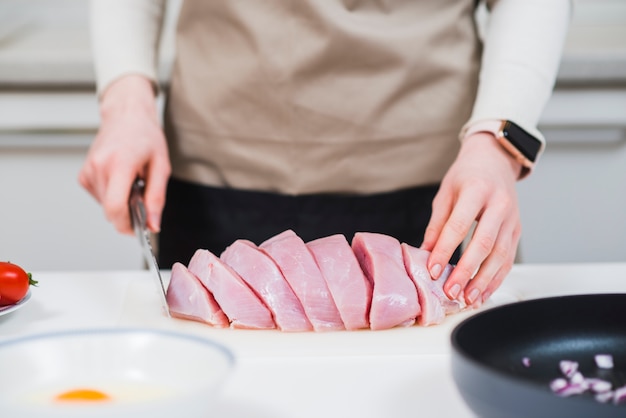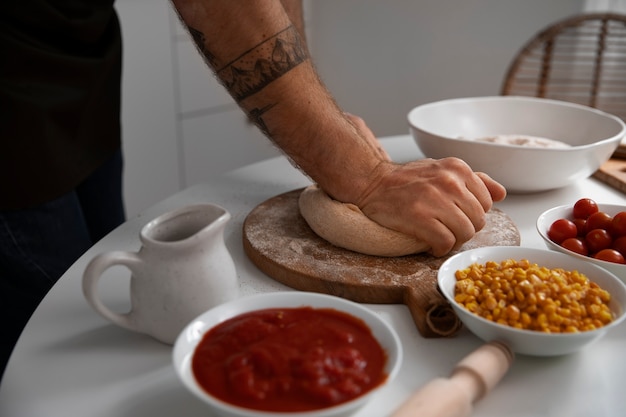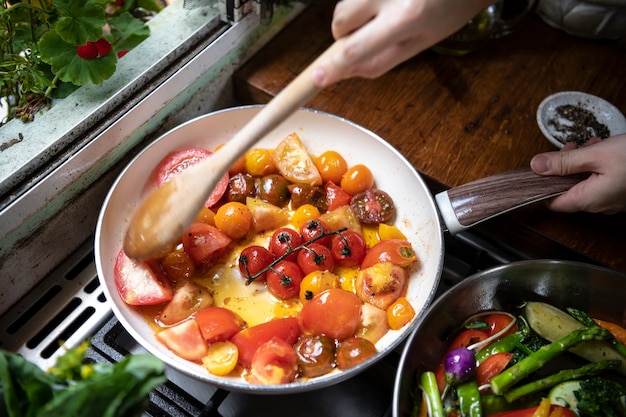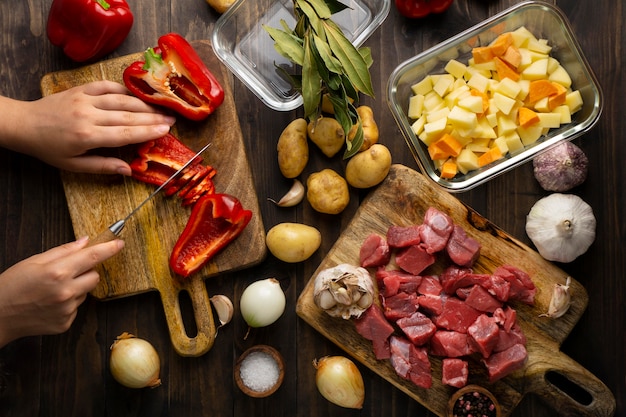Right, let's talk about Chinese sausage, or lap cheong as it's known in Cantonese. I've been a bit obsessed with these little bundles of flavour for years now, and I'm convinced they're the missing ingredient in so many dishes. It's not just about the taste, though – they're incredibly versatile. Whether you're after a quick stir-fry, a comforting noodle soup, or a flavour-packed rice dish, lap cheong can add that extra oomph you're looking for. And, trust me, once you experience the magic of this sausage, you'll be hooked.
In this guide, I'm going to share everything I've learned about cooking with Chinese sausage, from choosing the right type to mastering a few essential techniques. We'll explore the history of lap cheong, uncover its fascinating production process, and delve into its various forms and flavors. It's going to be a bit of a journey, so grab a cuppa and settle in. Let's dive in!
(Part 1) A Journey Through the World of Lap Cheong

Let's start by getting a bit more familiar with our star ingredient. Lap cheong, for those who don't know, is a type of Chinese sausage that's traditionally made from pork, but you can also find versions with duck or even chicken. It's dried and cured, giving it a unique flavour that's both salty and sweet, with a hint of smokiness. It's a truly unique ingredient that can elevate any dish.
A Bite of History: The Origins of Lap Cheong
The history of lap cheong goes back centuries, originating in Southern China, particularly the Guangdong province. It was a practical way to preserve pork during a time when refrigeration wasn't readily available. The drying and curing process not only extended the shelf life of the meat but also intensified its flavours, making it a prized delicacy.
Traditionally, lap cheong was made using a simple technique, with only a few essential ingredients: pork, salt, sugar, and spices. The meat was ground and mixed with these ingredients, then stuffed into casings and hung to dry. The drying process could take anywhere from a few days to several weeks, depending on the weather and humidity. Over time, this process evolved, with variations in ingredients and techniques emerging across different regions of China.
What Makes Lap Cheong So Special?
Well, it's all about the flavour and the texture. The drying process concentrates the flavours of the meat, resulting in something intensely delicious. Imagine a symphony of salty, sweet, and smoky notes dancing on your palate. It's a real sensory experience! And the texture is equally captivating – chewy and meaty, with a slight bite that adds a lovely contrast to any dish.
But what makes it truly stand out is its versatility. Lap cheong can be used in a huge range of dishes, from stir-fries and soups to rice dishes and even steamed dumplings. It's the perfect ingredient to add a little depth and complexity to your cooking. It's like a secret weapon that can transform ordinary meals into culinary masterpieces.
Types of Lap Cheong: A Spectrum of Flavors
You'll find different types of lap cheong available, each with its own unique flavour profile and texture. Let me tell you about a few of my favourites:
- Sweet Lap Cheong: This is the most common type, with a balance of sweetness and saltiness. It's perfect for stir-fries, noodle dishes, and rice dishes, adding a touch of sweetness without being overpowering.
- Spicy Lap Cheong: This variety has a kick of chilli for those who like things a little hotter. It adds a fantastic depth of flavour to rice dishes, dumplings, and stir-fries, delivering a pleasant warmth alongside the savoury notes.
- Sausage with Fat: This lap cheong has a higher fat content, resulting in a richer, more flavourful experience. It's perfect for dishes where you want a bit more decadence and a melt-in-your-mouth texture.
- Dried Lap Cheong: This type is dried for a longer period, making it harder and more intense in flavour. It's often used in soups and stews where it can simmer for a long time, releasing its flavour into the broth and creating a complex, satisfying depth.
Choosing The Right Lap Cheong: A Guide for the Discerning Cook
Choosing the right lap cheong can make a world of difference. When you’re browsing the supermarket shelves or your local Asian market, look for these things:
- Colour: The colour of good lap cheong is a deep red or brown, with a slight sheen. Avoid any sausage that looks pale or discoloured, as this may indicate that it's not fresh.
- Texture: A good lap cheong is firm to the touch, but not overly hard. If it feels dry or brittle, it’s probably too old. It should have a slight springiness to it.
- Smell: Fresh lap cheong should have a slightly sweet and smoky aroma. If you smell anything off or sour, walk away. This is a sign that the sausage has gone bad.
- Fat Content: The amount of fat in lap cheong can vary. If you prefer a richer flavour, choose a sausage with a higher fat content. But if you’re watching your fat intake, opt for a leaner variety.
(Part 2) Preparing Lap Cheong for Cooking: Unleashing the Flavor

Okay, so you’ve got your lap cheong – now what? Before you start cooking, you need to prepare it properly. It’s a quick and simple process that will make a big difference in the end result. Think of it as getting the sausage ready to shine!
Soaking Lap Cheong: Rehydrating the Sausage for Maximum Flavor
The most important step is to soak the lap cheong. This helps to soften it up and rehydrate it, allowing the flavours to really develop. Here’s how to do it:
- Place the lap cheong in a bowl of cold water. Make sure the water completely covers the sausage.
- Let it soak for about 30 minutes, or until it’s softened. You’ll know it’s ready when it feels pliable and no longer hard.
- Remove it from the water and pat it dry with kitchen paper. This will remove any excess moisture and prevent the sausage from becoming soggy.
There are some other little tips that make a difference. You can add a splash of rice wine or Shaoxing wine to the soaking water to enhance the flavour. The alcohol will infuse the sausage, adding a subtle complexity to its flavour. Or, if you're in a hurry, you can gently warm the water to speed up the softening process. Just don’t let it boil!
Slicing Lap Cheong: A Matter of Precision
Once the lap cheong is soaked, it’s time to slice it. You can use a sharp knife or a meat cleaver – whatever you feel comfortable with.
The size of the slices depends on the dish you’re making. For stir-fries, I like to slice it thinly. This allows the sausage to cook quickly and evenly, ensuring a nice crispy exterior and a tender interior. For soups or stews, you can cut it into larger chunks, giving the sausage a chance to infuse its flavour into the broth.
If you're feeling fancy, you can even spiral slice it with a mandoline for a pretty and decorative touch. Trust me, it’ll impress your guests! It's a great way to add a visual element to your dishes, making them even more appealing.
(Part 3) Cooking with Lap Cheong: Unleashing the Flavor

Now we're getting into the good stuff! This is where all the fun begins. I've got a few go-to techniques for cooking lap cheong that I want to share with you. These are the ones I’ve found to really bring out the best in this amazing ingredient. Get ready to unleash a symphony of flavour!
Stir-Frying Lap Cheong: The Quick and Delicious Method
Stir-frying is one of the easiest and most popular ways to cook lap cheong. It's a quick and flavourful method that's perfect for a weeknight dinner. Here’s the basic recipe:
- Heat some oil in a wok or a large frying pan over a high heat. The heat will ensure that the sausage cooks quickly and develops a beautiful crispy exterior.
- Add the sliced lap cheong and stir-fry for about 2-3 minutes, until it’s golden brown and crispy. The browning process will intensify the flavour and create a lovely texture.
- Add your other ingredients, such as vegetables, noodles, or rice, and stir-fry until everything is cooked through. This will create a harmonious blend of flavours and textures.
There are so many different variations you can try with stir-fried lap cheong. You could add some garlic, ginger, and chilli for a spicy kick. Or, for a more flavourful twist, add a splash of soy sauce, oyster sauce, or even hoisin sauce. Experiment with different combinations to discover your favourite flavour profiles.
Stewing with Lap Cheong: A Comforting and Flavorful Journey
Lap cheong is also delicious when stewed in a rich and flavourful broth. This is a classic way to cook it, and it’s perfect for cold weather. The long simmering process allows the sausage to infuse its flavour into the broth, creating a truly comforting and satisfying dish.
- Start by browning the lap cheong in a large pot or casserole dish over a medium heat. This will give the sausage a lovely caramelized flavour.
- Add your other ingredients, such as vegetables, tofu, or meat, and cook until everything is well combined. This will create a base for your delicious stew.
- Pour in some broth or water, and bring to a simmer. Let the flavours meld together and deepen.
- Cover the pot and let it simmer for at least 30 minutes, or until everything is tender. This will allow the ingredients to cook thoroughly and develop a rich flavour.
When it comes to stewing, the possibilities are endless. You could try a simple vegetable stew, a hearty beef and potato stew, or even a rich pork and noodle soup. A little bit of lap cheong can really elevate any stew, adding depth and complexity to the flavours.
Adding Lap Cheong to Rice Dishes: A Simple Yet Delicious Enhancement
For a simple but flavourful meal, try adding lap cheong to your rice. It's a great way to add a touch of savoury richness to a humble side dish. Here's how:
- Fry the lap cheong with some garlic and ginger until fragrant. This will infuse the rice with a wonderful aroma and flavour.
- Add the rice and stir-fry for a couple of minutes. This will coat the rice in the delicious oil and flavours from the sausage.
- Pour in enough water or broth to cover the rice, season with salt and pepper, and bring to a simmer. This will create a flavourful broth that will be absorbed by the rice.
- Cover the pot and let the rice simmer until all the liquid is absorbed. The rice will become fluffy and perfectly cooked.
You can also try adding vegetables, seafood, or other meats to create a more elaborate rice dish. For a special occasion, try adding some chopped spring onions and toasted sesame seeds for a finishing touch. These additions will create a visually appealing and flavourful dish.
Using Lap Cheong in Dumplings: A Culinary Fusion of Flavor and Texture
For a truly authentic experience, try incorporating lap cheong into your dumplings. It’s a great way to add a smoky and salty flavour to these little parcels of goodness. You can use it in both steamed and fried dumplings, as well as pot stickers. It's a delicious combination of textures and flavours that will delight your taste buds.
My favourite way to use lap cheong in dumplings is to mix it with minced pork and vegetables. Just be sure to mince the lap cheong very finely to ensure it cooks evenly. This will prevent the sausage from becoming tough and ensure a consistent texture in the dumpling filling.
(Part 4) Recipes with Lap Cheong: A culinary adventure Awaits
You’ve got the basics – now let’s get into some specific recipes. I’m going to share some of my favourites that are perfect for showcasing the versatility of lap cheong. Get ready to unleash your creativity and explore the world of lap cheong cuisine!
1. Stir-Fried Lap Cheong with Vegetables: A Quick and Delicious Weeknight Meal
This is a quick and easy recipe that’s perfect for a weeknight dinner. The combination of the sweet and salty lap cheong with the fresh vegetables is truly delicious. It's a simple yet satisfying dish that will leave you wanting more.
Ingredients:
- 2 tablespoons of vegetable oil
- 100g of lap cheong, sliced thinly
- 1 onion, sliced
- 1 bell pepper, sliced
- 1 red chilli, finely chopped (optional)
- 1 clove of garlic, minced
- 1 teaspoon of grated ginger
- 1 tablespoon of soy sauce
- 1/2 teaspoon of sugar
- 1/4 teaspoon of black pepper
Instructions:
- Heat the oil in a wok or a large frying pan over a high heat.
- Add the lap cheong and stir-fry for about 2-3 minutes, until it’s golden brown and crispy.
- Add the onion, bell pepper, chilli, garlic, and ginger. Stir-fry for a further 2-3 minutes, until the vegetables are softened.
- Add the soy sauce, sugar, and pepper. Stir-fry for another minute, until everything is well combined.
- Serve hot with rice or noodles.
2. Lap Cheong and Pork Noodle Soup: A Comforting and Nourishing Delight
This is a comforting and nourishing soup that’s perfect for a cold day. The lap cheong adds a lovely depth of flavour to the broth, and the combination of pork and noodles is a classic for a reason. This soup is sure to warm you from the inside out.
Ingredients:
- 1 tablespoon of vegetable oil
- 100g of lap cheong, sliced into 1-inch pieces
- 1 pound of pork belly, cut into 1-inch cubes
- 1 onion, diced
- 2 cloves of garlic, minced
- 1 piece of ginger, sliced
- 6 cups of chicken broth or water
- 1 teaspoon of salt
- 1/2 teaspoon of black pepper
- 1/2 teaspoon of Chinese five spice powder
- 1/4 cup of soy sauce
- 1/4 cup of rice wine
- 1/2 cup of fresh cilantro, chopped
- 1/2 cup of cooked egg noodles
Instructions:
- Heat the oil in a large pot or dutch oven over a medium heat.
- Add the lap cheong and pork belly. Cook for about 5-7 minutes, until browned on all sides.
- Add the onion, garlic, and ginger. Cook for a further 2-3 minutes, until fragrant.
- Pour in the chicken broth or water, salt, pepper, five spice powder, soy sauce, and rice wine. Bring to a boil, then reduce the heat to a simmer.
- Cover the pot and let it simmer for at least 30 minutes, or until the pork is tender.
- Serve hot with cooked egg noodles and a sprinkle of fresh cilantro.
3. Lap Cheong fried rice: A Cantonese Classic Reimagined
This is a classic Cantonese dish that’s both flavourful and easy to make. The lap cheong adds a delicious salty and sweet flavour to the rice, and the combination of vegetables and egg creates a truly satisfying meal. It's a perfect option for a quick and easy lunch or dinner.
Ingredients:
- 2 tablespoons of vegetable oil
- 100g of lap cheong, sliced into 1/2-inch pieces
- 1 onion, diced
- 1 red bell pepper, diced
- 2 cloves of garlic, minced
- 1 teaspoon of grated ginger
- 2 cups of cooked rice
- 1/4 cup of soy sauce
- 1/4 cup of chicken broth
- 1 egg, beaten
- 1/4 cup of chopped spring onions
- 1 tablespoon of toasted sesame seeds
Instructions:
- Heat the oil in a wok or a large frying pan over a medium heat.
- Add the lap cheong and cook for about 2-3 minutes, until it’s golden brown and crispy.
- Add the onion, bell pepper, garlic, and ginger. Cook for a further 2-3 minutes, until the vegetables are softened.
- Add the cooked rice, soy sauce, and chicken broth. Stir-fry for another 2-3 minutes, until everything is well combined.
- Pour the beaten egg into the wok or frying pan, and stir quickly, scrambling it into the rice mixture.
- Serve hot with a sprinkle of spring onions and sesame seeds.
(Part 5) Storage and Leftovers: Making the Most of Your Culinary Creations
Alright, you've cooked up a storm with your lap cheong – but what about those leftovers? Let's make sure you get the most out of your delicious creations. Proper storage and creative use of leftovers are key to maximizing the enjoyment of your lap cheong dishes.
Storing Lap Cheong: Keeping the Flavour Intact
If you’ve got some lap cheong leftover, you’ll want to store it properly to keep it fresh. The best way to do this is to wrap it tightly in plastic wrap or aluminum foil and store it in the refrigerator. It should last for up to a week. This will help to prevent the sausage from drying out and preserve its delicious flavour.
Using Leftover Lap Cheong: A Symphony of Flavour in Every Meal
Leftover lap cheong can be used in a variety of ways. It’s great for adding a flavour boost to soups, stews, and stir-fries. The intense flavour of the sausage will add depth and complexity to these dishes. You can also slice it thinly and use it as a topping for salads or sandwiches. This will add a salty and smoky element to your meal.
Freezing Lap Cheong: Preserving the Flavour for Future Culinary Adventures
If you have a large amount of lap cheong and you won’t be using it all up, you can freeze it. Simply wrap it tightly in plastic wrap or aluminum foil and place it in a freezer bag. It should last for up to 3 months in the freezer. This will ensure that the sausage stays fresh and flavorful for future culinary adventures.
When you’re ready to use it, just thaw it in the refrigerator overnight. Just make sure you don’t refreeze it once it’s thawed. Refreezing can compromise the texture and flavour of the sausage.
(Part 6) Variations and Substitutions: Expanding Your Culinary Horizons
I’ve talked about the classic lap cheong, but there’s a whole world of variations out there! If you’re feeling adventurous, try these. You never know what delicious discoveries await you in the world of lap cheong!
Lap Cheong with Duck: A Rich and Delicate Treat
This is a more luxurious version of lap cheong that’s made with duck meat. It has a richer flavour and a slightly more delicate texture. It's fantastic in stir-fries and rice dishes, adding a touch of elegance to your meal.
Lap Cheong with Chicken: A Lighter and Fresher Option
This is a lighter version of lap cheong that’s made with chicken meat. It’s a good option for those who are looking for a less fatty alternative. It’s great for stir-fries, soups, and dumplings, offering a lighter and more refreshing flavour.
Spicy Lap Cheong: A Fiery Kick for Those Who Like It Hot
If you like things hot, this lap cheong is for you! It’s packed with chilli peppers, giving it a fiery kick. It’s perfect for adding some heat to rice dishes, noodles, and stir-fries, providing a delicious contrast to the sweet and salty flavours of the sausage.
Substituting Lap Cheong: Exploring Other Flavour Profiles
If you can’t find lap cheong, you can use other types of sausage as a substitute. Here are some options:
- Chorizo: spanish chorizo has a similar flavour profile to lap cheong, with a spicy and smoky kick. It’s a good choice for stir-fries and rice dishes, adding a touch of Spanish flair to your meal.
- italian sausage: Italian sausage, especially the sweet variety, can also be a good substitute for lap cheong. It’s great for adding flavour to soups, stews, and pasta dishes, lending a touch of Italian authenticity to your cuisine.
Remember, when substituting lap cheong, you may need to adjust the seasoning in your recipe to compensate for the different flavour profile. Experiment with different seasonings and ingredients to find the perfect combination.
(Part 7) A culinary journey: Exploring the World of Lap Cheong
Let me tell you, cooking with lap cheong is like taking a culinary journey to another land. Each bite is a little adventure, with a blend of sweet, salty, and smoky flavours that will leave you wanting more. It’s more than just an ingredient – it’s a way of life.
It’s a tradition that’s been passed down through generations, a taste of home, a connection to heritage. That's what makes it so special. It’s not just about the food – it’s about the stories and memories that are woven into every recipe. Each bite of lap cheong is a reminder of a rich and vibrant culture.
So, go out and explore the world of lap cheong! Experiment with different recipes and techniques. You might just discover a new favourite ingredient, one that will spice up your cooking and transport you to another place and time. The possibilities are endless when it comes to lap cheong, so embrace the journey and let your culinary imagination run wild!
(Part 8) FAQs: Addressing the Burning Questions
Now, let’s tackle some of those burning questions you might have about lap cheong. It's time to clear up any confusion and get you ready to confidently embrace this delicious ingredient.
1. What does lap cheong taste like?
Lap cheong has a unique flavour that’s both salty and sweet, with a smoky undertone. It’s a bit like a combination of bacon and sausage, with a hint of sweetness. The exact flavour profile will vary depending on the type of lap cheong you’re using, but it’s always full of flavour. Think of it as a complex tapestry of tastes that will tantalize your taste buds.
2. How do you know if lap cheong is bad?
If lap cheong is bad, it will have a sour or off smell. It may also be dry and brittle to the touch. If you see any mold or discoloration, it’s best to discard it. It's important to ensure that the sausage is fresh and safe to eat.
3. What is lap cheong made of?
Lap cheong is traditionally made from pork, but you can also find versions with duck or chicken. It’s cured and dried, giving it its unique flavour and texture. The curing process involves adding salt and spices, which draw out moisture and create a concentrated flavour. The drying process further intensifies the flavours and produces the characteristic chewy texture.
4. How long does lap cheong last?
Unopened lap cheong can last for several months in the refrigerator, but once it’s opened, it’s best to use it within a week. You can also freeze lap cheong for up to 3 months. Proper storage is crucial for maintaining the quality and flavour of the sausage.
5. Where can you buy lap cheong?
Lap cheong is widely available in Asian grocery stores and some supermarkets. You can also find it online from various retailers. It's becoming increasingly popular, so you shouldn't have any trouble finding it in most major cities.
Well, that's it! I hope this guide has given you the confidence to explore the wonderful world of lap cheong. Go on, get cooking! I’m off to try out some new recipes, and I can’t wait to hear about your culinary adventures with lap cheong. Happy cooking!
Everyone is watching

Perfect Rice Every Time: The Ultimate Guide to Cooking Rice
Cooking TipsAs a self-proclaimed foodie, I've always been a bit obsessed with rice. It's the foundation of countless cuisi...

The Ultimate Guide to Cooking Asparagus: Tips, Techniques, and Recipes
Cooking TipsAsparagus. The mere mention of this spring delicacy conjures up images of vibrant green spears, crisp and burs...

Ultimate Guide to Cooking the Perfect Thanksgiving Turkey
Cooking TipsThanksgiving. Just the word conjures up images of overflowing tables laden with delicious food, the scent of r...

Can You Cook Spaghetti with Gasoline? (The Shocking Truth)
Cooking TipsWe've all seen those crazy internet trends. You know, the ones that make you wonder, "Did someone actually try...

Chorizo and Eggs Recipe: The Ultimate Guide
Cooking TipsRight, let’s talk about chorizo and eggs. You know, that classic Spanish dish that's always a winner. It's th...
